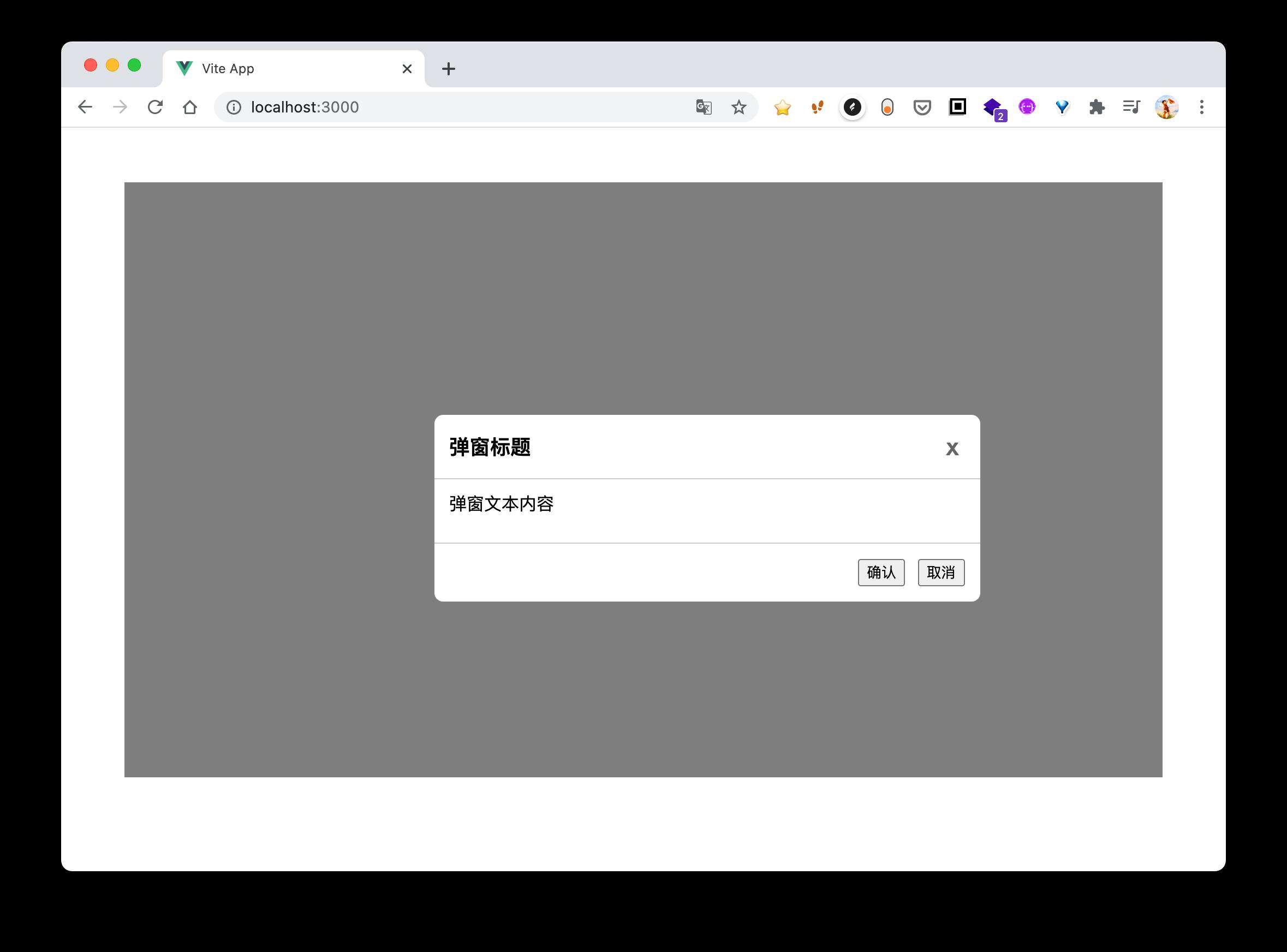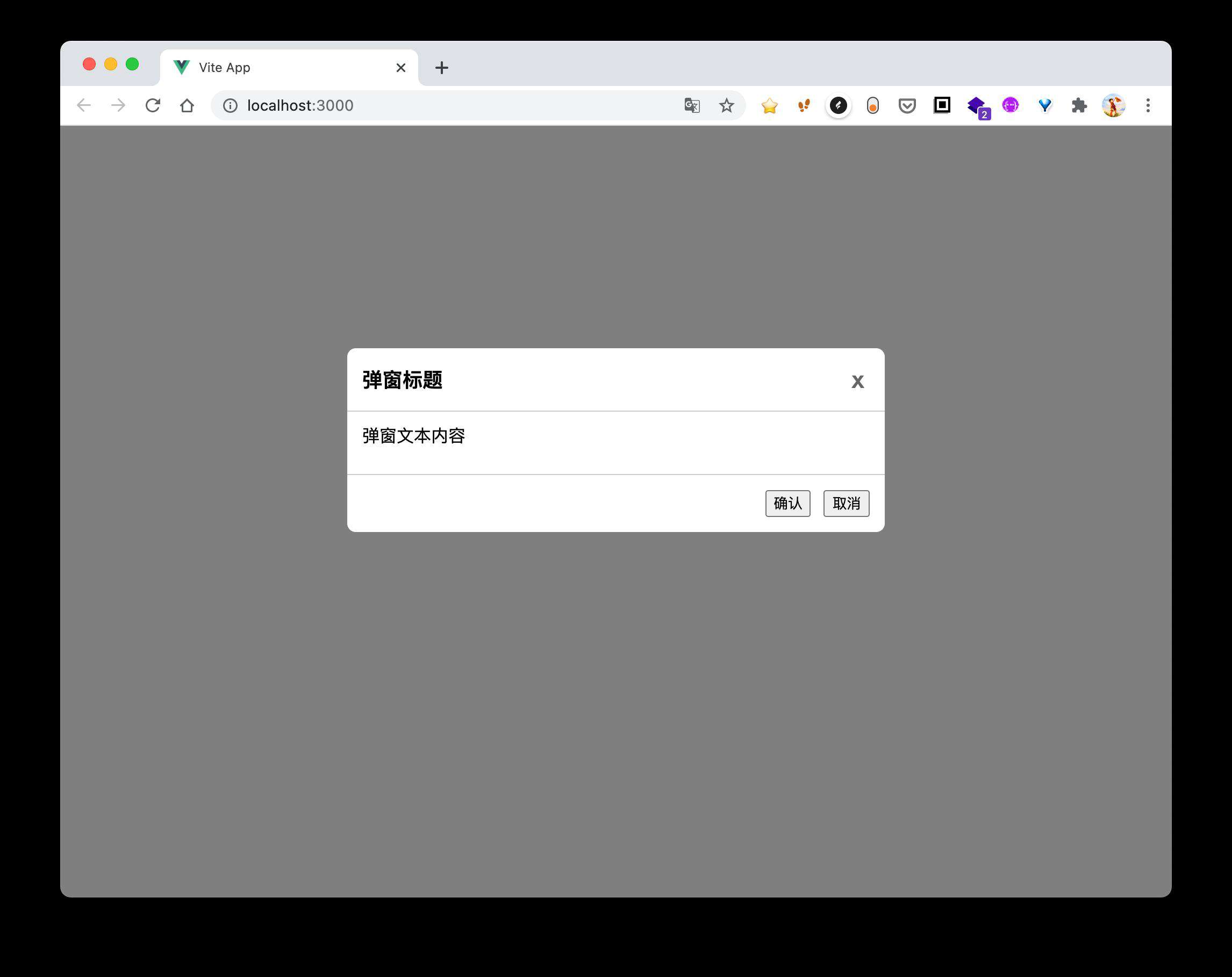Vue3 的组合式 API 以及基于 Proxy 响应式原理已经有很多文章介绍过了,除了这些比较亮眼的更新,Vue3 还新增了一个内置组件:Teleport。这个组件的作用主要用来将模板内的 DOM 元素移动到其他位置。
使用场景
业务开发的过程中,我们经常会封装一些常用的组件,例如 Modal 组件。相信大家在使用 Modal 组件的过程中,经常会遇到一个问题,那就是 Modal 的定位问题。
话不多说,我们先写一个简单的 Modal 组件。
<!-- Modal.vue -->
<style lang="scss">
.modal {
&__mask {
position: fixed;
top: 0;
left: 0;
width: 100vw;
height: 100vh;
background: rgba(0, 0, 0, 0.5);
}
&__main {
margin: 0 auto;
margin-bottom: 5%;
margin-top: 20%;
width: 500px;
background: #fff;
border-radius: 8px;
}
/* 省略部分样式 */
}
</style>
<template>
<div class="modal__mask">
<div class="modal__main">
<div class="modal__header">
<h3 class="modal__title">弹窗标题</h3>
<span class="modal__close">x</span>
</div>
<div class="modal__content">
弹窗文本内容
</div>
<div class="modal__footer">
<button>取消</button>
<button>确认</button>
</div>
</div>
</div>
</template>
<script>
export default {
setup() {
return {};
},
};
</script>
然后我们在页面中引入 Modal 组件。
<!-- App.vue -->
<style lang="scss">
.container {
height: 80vh;
margin: 50px;
overflow: hidden;
}
</style>
<template>
<div class="container">
<Modal />
</div>
</template>
<script>
export default {
components: {
Modal,
},
setup() {
return {};
}
};
</script>

如上图所示, div.container 下弹窗组件正常展示。使用 fixed 进行布局的元素,在一般情况下会相对于屏幕视窗来进行定位,但是如果父元素的 transform, perspective 或 filter 属性不为 none 时,fixed 元素就会相对于父元素来进行定位。
我们只需要把 .container 类的 transform 稍作修改,弹窗组件的定位就会错乱。
<style lang="scss">
.container {
height: 80vh;
margin: 50px;
overflow: hidden;
transform: translateZ(0);
}
</style>

这个时候,使用 Teleport 组件就能解决这个问题了。
我们只需要将弹窗内容放入 Teleport 内,并设置 to 属性为 body,表示弹窗组件每次渲染都会做为 body 的子级,这样之前的问题就能得到解决。
<template>
<teleport to="body">
<div class="modal__mask">
<div class="modal__main">
...
</div>
</div>
</teleport>
</template>
可以在 codesandbox.io/embed/vue-m… 查看代码。

源码解析
我们可以先写一个简单的模板,然后看看 Teleport 组件经过模板编译后,生成的代码。
Vue.createApp({
template: `
<Teleport to="body">
<div> teleport to body </div>
</Teleport>
`
})

简化后代码:
function render(_ctx, _cache) {
with (_ctx) {
const { createVNode, openBlock, createBlock, Teleport } = Vue
return (openBlock(), createBlock(Teleport, { to: "body" }, [
createVNode("div", null, " teleport to body ", -1 /* HOISTED */)
]))
}
}
可以看到 Teleport 组件通过 createBlock 进行创建。
// packages/runtime-core/src/renderer.ts
export function createBlock(
type, props, children, patchFlag
) {
const vnode = createVNode(
type,
props,
children,
patchFlag
)
// ... 省略部分逻辑
return vnode
}
export function createVNode(
type, props, children, patchFlag
) {
// class & style normalization.
if (props) {
// ...
}
// encode the vnode type information into a bitmap
const shapeFlag = isString(type)
? ShapeFlags.ELEMENT
: __FEATURE_SUSPENSE__ && isSuspense(type)
? ShapeFlags.SUSPENSE
: isTeleport(type)
? ShapeFlags.TELEPORT
: isObject(type)
? ShapeFlags.STATEFUL_COMPONENT
: isFunction(type)
? ShapeFlags.FUNCTIONAL_COMPONENT
: 0
const vnode: VNode = {
type,
props,
shapeFlag,
patchFlag,
key: props && normalizeKey(props),
ref: props && normalizeRef(props),
}
return vnode
}
// packages/runtime-core/src/components/Teleport.ts
export const isTeleport = type => type.__isTeleport
export const Teleport = {
__isTeleport: true,
process() {}
}
传入 createBlock 的第一个参数为 Teleport,最后得到的 vnode 中会有一个 shapeFlag 属性,该属性用来表示 vnode 的类型。isTeleport(type) 得到的结果为 true,所以 shapeFlag 属性最后的值为 ShapeFlags.TELEPORT(1 << 6)。
// packages/shared/src/shapeFlags.ts
export const enum ShapeFlags {
ELEMENT = 1,
FUNCTIONAL_COMPONENT = 1 << 1,
STATEFUL_COMPONENT = 1 << 2,
TEXT_CHILDREN = 1 << 3,
ARRAY_CHILDREN = 1 << 4,
SLOTS_CHILDREN = 1 << 5,
TELEPORT = 1 << 6,
SUSPENSE = 1 << 7,
COMPONENT_SHOULD_KEEP_ALIVE = 1 << 8,
COMPONENT_KEPT_ALIVE = 1 << 9
}
在组件的 render 节点,会依据 type 和 shapeFlag 走不同的逻辑。
// packages/runtime-core/src/renderer.ts
const render = (vnode, container) => {
if (vnode == null) {
// 当前组件为空,则将组件销毁
if (container._vnode) {
unmount(container._vnode, null, null, true)
}
} else {
// 新建或者更新组件
// container._vnode 是之前已创建组件的缓存
patch(container._vnode || null, vnode, container)
}
container._vnode = vnode
}
// patch 是表示补丁,用于 vnode 的创建、更新、销毁
const patch = (n1, n2, container) => {
// 如果新旧节点的类型不一致,则将旧节点销毁
if (n1 && !isSameVNodeType(n1, n2)) {
unmount(n1)
}
const { type, ref, shapeFlag } = n2
switch (type) {
case Text:
// 处理文本
break
case Comment:
// 处理注释
break
// case ...
default:
if (shapeFlag & ShapeFlags.ELEMENT) {
// 处理 DOM 元素
} else if (shapeFlag & ShapeFlags.COMPONENT) {
// 处理自定义组件
} else if (shapeFlag & ShapeFlags.TELEPORT) {
// 处理 Teleport 组件
// 调用 Teleport.process 方法
type.process(n1, n2, container...);
} // else if ...
}
}
可以看到,在处理 Teleport 时,最后会调用 Teleport.process 方法,Vue3 中很多地方都是通过 process 的方式来处理 vnode 相关逻辑的,下面我们重点看看 Teleport.process 方法做了些什么。
// packages/runtime-core/src/components/Teleport.ts
const isTeleportDisabled = props => props.disabled
export const Teleport = {
__isTeleport: true,
process(n1, n2, container) {
const disabled = isTeleportDisabled(n2.props)
const { shapeFlag, children } = n2
if (n1 == null) {
const target = (n2.target = querySelector(n2.prop.to))
const mount = (container) => {
// compiler and vnode children normalization.
if (shapeFlag & ShapeFlags.ARRAY_CHILDREN) {
mountChildren(children, container)
}
}
if (disabled) {
// 开关关闭,挂载到原来的位置
mount(container)
} else if (target) {
// 将子节点,挂载到属性 `to` 对应的节点上
mount(target)
}
}
else {
// n1不存在,更新节点即可
}
}
}
其实原理很简单,就是将 Teleport 的 children 挂载到属性 to 对应的 DOM 元素中。为了方便理解,这里只是展示了源码的九牛一毛,省略了很多其他的操作。
总结
希望在阅读文章的过程中,大家能够掌握 Teleport 组件的用法,并使用到业务场景中。尽管原理十分简单,但是我们有了 Teleport 组件,就能轻松解决弹窗元素定位不准确的问题。

常见问题FAQ
- 免费下载或者VIP会员专享资源能否直接商用?
- 本站所有资源版权均属于原作者所有,这里所提供资源均只能用于参考学习用,请勿直接商用。若由于商用引起版权纠纷,一切责任均由使用者承担。更多说明请参考 VIP介绍。
- 提示下载完但解压或打开不了?
- 找不到素材资源介绍文章里的示例图片?
- 模板不会安装或需要功能定制以及二次开发?






发表评论
还没有评论,快来抢沙发吧!